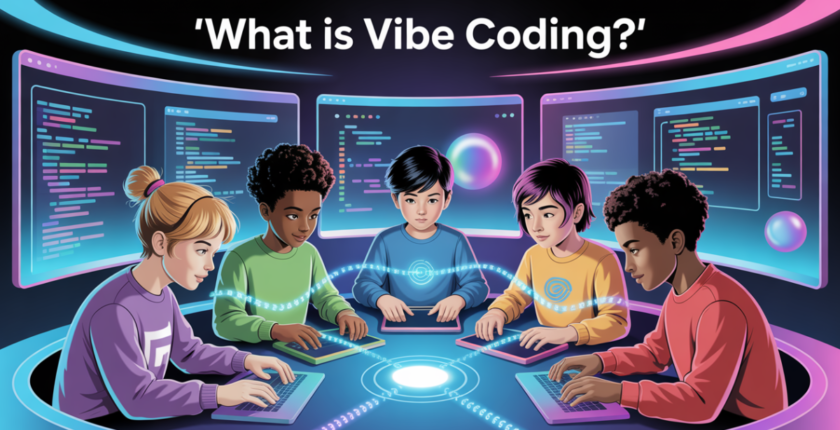What is Vibe Coding ? A Beginner’s Guide for Freshers and Students
What is Vibe Coding : More quickly than ever before, the world of coding is evolving. The way that we write and work together on code is changing, from conventional programming languages to AI-powered development tools. Vibe Coding, a novel approach to coding that combines creativity, real-time collaboration, and AI-assisted development, is among the most intriguing trends in this evolution. Vibe coding emphasizes flow, collaboration, and creativity in contrast to traditional approaches, where coding frequently feels rigid or isolating.
Vibe coding can be a game-changer for students and newcomers to the tech industry. Vibe coding fosters a more participatory and community-driven atmosphere as opposed to a solitary workspace with lines of code. It makes coding feel more natural—almost like speaking with technology—by utilizing AI tools, collaborative platforms, and contemporary workflows. Vibe coding is becoming a key concept in today’s fast-paced IT job market, where flexibility and creativity are just as important as technical proficiency.
Vibe coding, to put it simply, is coding with the appropriate rhythm and resources. It stimulates innovation, speeds up development, and lowers errors by fusing human creativity with AI support. Vibe coding keeps you in sync with your coworkers and the technology you use, whether you’re working on your first project, a startup, or an open-source platform. Let’s now examine vibe coding’s salient characteristics and the reasons it will be important for new hires in 2025 and beyond.
How to Create AI Agents: A Complete Guide for Beginners
1. Real-Time Collaborative Coding
Vibe coding is fundamentally about teamwork in real time. Vibe coding allows multiple developers to code simultaneously using tools like Visual Studio Live Share, CodeSandbox, or Replit multiplayer mode, in contrast to the previous paradigm of writing code independently and then merging it later. This promotes a smoother project flow, fewer conflicts, and quicker brainstorming.
This is particularly beneficial for newcomers since it lets them learn from their peers while coding in real time. They can see various approaches to problem-solving, receive instant feedback, and build confidence without having to wait for code reviews. This collaborative approach is very relevant for students getting ready for the workforce because it reflects how contemporary businesses function in remote and hybrid settings.
2. AI-Powered Coding Assistance
Vibe coding involves more than just teamwork; it also involves using AI coding assistants. Developers can finish tasks, troubleshoot issues, and make real-time optimization suggestions with the aid of tools like GitHub Copilot, ChatGPT Code Interpreter, and Tabnine. AI offers direction so programmers can remain “in the vibe” of building rather than wasting hours on grammatical mistakes or logical lapses.
This speeds up the learning curve and lessens frustration for new hires. Vibe coding fosters an atmosphere where novices feel encouraged rather than overwhelmed by fusing human creativity with AI’s efficiency. Students’ coding and communication skills improve as they gain experience in creating better prompts and queries for AI tools.
3. Creative and Flow-Oriented Coding
Traditional coding, which places a lot of emphasis on syntax and error handling, frequently feels inflexible. This is reversed by vibe coding, which promotes an imaginative and fluid way of thinking. The goal is to maintain programmers in their “flow state,” which is a state of complete immersion and productivity. Using AI tools, templates, and integrated development environments (IDEs) made for smooth coding reduces disruptions like continuous debugging or manual setup.
For students, this is significant because it reduces the fear associated with coding. Employers genuinely value logic, design, and problem-solving skills, so they can concentrate on these instead of getting bogged down in small errors. It turns coding into a fun, almost creative process rather than a stressful chore.
🛑Learn Vibe Coding now and start earning🛑
4. Hybrid of Learning and Building
The gap between learning to code and creating actual projects is also filled by vibe coding. Before using the theory in practical projects, students used to frequently spend months studying it. Vibe coding platforms allow students to create projects while they study, putting concepts into practice in real time. This is in line with project-based learning, which is among the best ways to learn how to code.
This method helps new hires establish solid portfolios early in their careers. They can demonstrate cooperative, AI-supported projects that highlight both technical and teamwork skills rather than claiming to only “know Java” or “know Python.” In highly competitive IT markets, this greatly increases employability.
5. Community-Driven Development
The community-driven culture of vibe coding is another significant feature. Vibe coding is supported by platforms such as Stack Overflow communities, Replit, and GitHub, which provide open collaboration, shared projects, and rapid peer review. Everyone now contributes ideas, snippets, and solutions to the shared experience of coding, making it no longer a solitary endeavor.
This is extremely beneficial for novices and students as it increases exposure, confidence, and networking opportunities. Freshmen can interact with international communities, learn industry standards, and even get internships or job referrals by working together on vibe coding projects.
6. Gamification and Motivation in Coding
To keep students interested, a lot of vibe coding platforms employ gamification strategies like achievement badges, coding challenges, and leaderboards. This encourages students to code more frequently and advance their abilities by introducing a playful and competitive element.
Gamified vibe coding gives newcomers, who frequently struggle with self-discipline when learning programming, a sense of accomplishment and progress. Building coding habits is crucial for long-term professional advancement, and this little incentive goes a long way in that direction.
7. Accessibility and Low-Barrier Entry
Vibe coding tools are frequently lightweight and browser-based, in contrast to traditional coding setups that required extensive installations and intricate configurations. Anyone with a laptop and an internet connection can begin coding right away with platforms like Replit, Glitch, and CodeSandbox.
This low entry barrier makes vibe coding accessible to all students, even those who are new to the field or have non-technical backgrounds. It encourages the democratization of coding, which will make it possible for more recent graduates to engage in the digital economy without facing technological obstacles.
8. Preparing for the Future of Work
Lastly, vibe coding is a great fit for the future of AI-powered and remote work. Collaborative and AI-assisted coding will become the new norm as businesses embrace hybrid workflows. In addition to knowing programming languages, employers will anticipate that graduates will be able to use tools that integrate coding with automation, artificial intelligence, and teamwork.
Those freshmen who adopt vibe coding early on will benefit greatly. They will have the proper attitude, useful abilities, and portfolio to make an impression on recruiters. Essentially, vibe coding teaches you how to work like a contemporary developer in addition to teaching you how to write code.
Prompt Engineering for Freshers : Talk to AI Like a Pro
Conclusion
More than just a catchphrase, vibe coding is a novel approach to programming that combines creativity, AI tools, and teamwork. It offers students and newcomers the chance to pick things up more quickly, create better projects, and get ready for the tech jobs of the future. Vibe coding transforms programming into an exciting, captivating, and future-ready skill through real-time collaboration, AI-powered support, gamification, and community-driven development.
Investigating vibe coding platforms and tools ought to be at the top of your to-do list if you’re a student or newbie hoping to begin your IT career. You’ll get closer to understanding the coding of the future the sooner you adjust.



